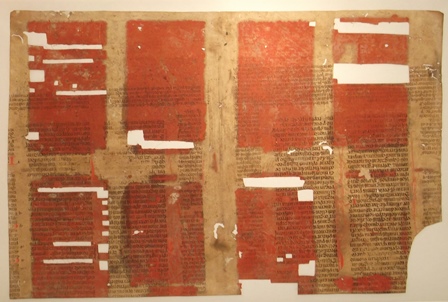In 2011, conservator Andrew Honey wrote about a frisket in the Bodleian’s Broxbourne collection. We repost Andrew’s piece here with a full image and with a link to further information on colour printing with friskets.

The Conservation Section is currently devising a new mount for a parchment frisket cover from the Broxbourne collection. A frisket is the part of a printing press that holds the paper in place during printing. Often covered with parchment, a frisket also acted as a mask to keep inky parts of the press bed from marking the printed paper.
The frisket cover (Broxb. 97.40), which is made from a recycled manuscript leaf, was framed behind glass when it came to the library and only one side could be seen. The library’s Rare Books curators asked whether it could be unframed and mounted so that both sides could be seen, and to make it more readily available for study. Once the Broxbourne frisket was released from its frame far more information about its early use and subsequent history could be seen.
A page of a manuscript
Manuscript writing can be seen on this piece of parchment, which has been identified as a page of an Italian fourteenth-century Canon Law text.
A “mask” for printing in colour
Two centuries later, this discarded piece of parchment from a law manuscript was used to make the frisket. The frisket was used to print the red portion of an octavo-format book in the early sixteenth century, and offers early evidence of two-colour printing processes. Here, areas of parchment were cut away to allow the red-inked type to print initials and so on, while the remaining parchment masked off the text which was to be printed in black. The attached photograph shows the upper side of the frisket cover and a detail of one page in raking light, which clearly shows impressions of type.
A lining for a bookbinding
Now that the frisket cover is out of its frame it can be seen that it was subsequently used as a board lining for a large folio bookbinding.
The final question remains – what was it used to print?
– Andrew Honey, Conservation, Bodleian Libraries. 2011.
